2 Free bus travel for older and disabled people
2 Free bus travel for older and disabled people
2.1 The current scheme for older and disabled people provides free bus travel within Scotland and to Carlisle and Berwick-upon-Tweed on any registered bus service to anyone who lives in Scotland, who is aged 60 and over or meets certain disability criteria, and who has applied for and received a National Entitlement Card (or “bus pass”). In addition, residents of Orkney, Shetland and the Western Isles who meet these criteria are entitled to 2 free return ferry journeys to the mainland each year. A history of earlier concessionary travel schemes in Scotland is provided at Annex A.
Benefits of free bus travel
2.2 One of the stated objectives of the Scheme when it was set up in 2006 was to allow older and disabled people improved access to services, facilities and social networks by free scheduled bus services; and so promote social inclusion.
2.3 Research has been undertaken on the benefits of concessionary travel schemes, including a report by the bus industry group, Greener Journeys, “The costs and benefits of concessionary bus travel for older and disabled people”[1].
2.4 In Scotland, we undertook our own customer feedback research in 2013[2] and 2014[3] to gather the views of bus pass holders on the scheme.
2.5 The research demonstrates that the Scheme is greatly valued and works well for bus pass holders for a number of reasons including financial savings, reducing isolation, giving a sense of greater independence and increasing confidence in their own ability to travel. It also highlights how bus pass holders see the Scheme as having improved their mental and physical well-being and has encouraged modal shift from car to public transport and increased use of the bus. Almost half of respondents in our survey said they now made journeys they would not previously have done, in particular for day trips and visiting friends and relatives.
Objectives of the Scheme
2.6 The key objectives for the Scheme include:-
- allowing older and disabled people improved access to services, facilities and social networks; and so promoting social inclusion;
- improving health by promoting a more active lifestyle;
- promoting modal shift from private car to public transport;
- maintaining a “no better, no worse off” position for bus operators with a standard reimbursement rate;
- providing opportunity for improvements to public transport;
- stimulating the introduction of smart cards.
2.7 Since the Scheme was introduced there have been minor modifications, such as simplifying the application process for eligible armed forces veterans in 2012 and changes in 2013 to include people receiving the new Personal Independence Payments (PIP).
2.8 In addition, between 2014 and 2016 new bus passes were issued to replace all existing ones. This was to ensure that they would be smart enabled in order to take advantage of the advances in technology since 2006. The new “saltirecard” branded bus passes ensure that card holders are able to make greater use of smart technology.
Eligibility
2.9 The current eligibility criteria are set down in legislation[4].
How free bus travel is funded
Figure 1: Reimbursement rate
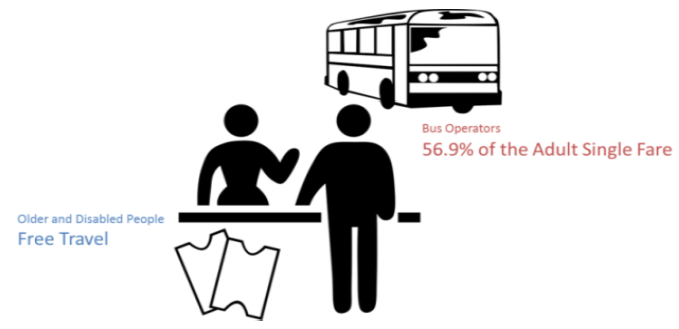
2.10 Bus pass holders travel for free. Travel through the national scheme is paid for directly by the Scottish Government. It is a principle of the Scheme that operators should be no better and no worse off as a result of their participation.
2.11 The Scottish Government reimburses bus operators for carrying bus pass holders at an agreed rate negotiated with representatives of the bus industry. This is called the reimbursement rate. In 2006-7 the rate was set at 73.6% of the adult single fare for each concessionary journey and, thanks largely to refinements in the economic model used to calculate the rate, has since gradually reduced to 56.9% of the adult single fare in 2017-18.
2.12 So, for every journey made on a bus by a bus pass holder under the Scheme, the bus service operator is currently paid 56.9% of the adult single fare for that journey by the Scottish Government.
Number of bus pass holders
2.13 In the first year of the Scheme, around 900,000 people obtained a National Entitlement Card enabling them to travel for free by bus. This number has gradually increased so that there are now over 1.3 million bus pass holders under the Scheme. Of these around 1.13 million are eligible by age and around 167,000 meet one or more of the disability criteria. Of these 167,000, around 120,000 are eligible for a companion to travel with them free of charge.
1.3 million people have National Concessionary Travel Scheme cards in Scotland
2.14 The following graph sets out the increase in numbers of bus pass holders since 2006.
Figure 2: Trend in concessionary card holders numbers
Numbers of Bus Pass Holders
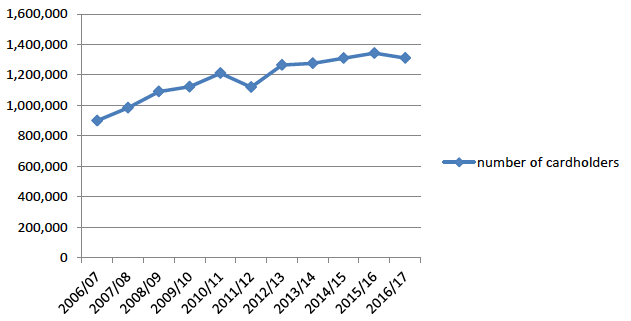
Journeys made by free bus travel
2.15 Scheme bus pass holders have made over 1,640 million journeys by bus since 2006. There was a small decline in usage between 2007-08 and 2012-13, partly coinciding with the move from “show and go” to smart ticketing. This has since stabilised to around 145 million journeys per year, almost one third of all bus journeys made in Scotland.
2.16 For a variety of reasons, including greatly increased car ownership, bus patronage in general has been continually declining since at least the 1960s. Between 2006-7 and 2014-15 (the most recent year for which we have figures) the number of bus journeys in Scotland fell from 476 million a year to 414 million. The most pronounced decline coincided with the economic downturn and the position has been a little more steady in the past few years. The graph below illustrates this trend over the past decade.
Figure 3: Trend in bus journeys
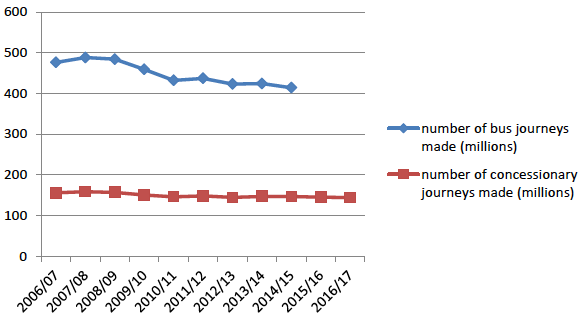
Projected future costs of free bus travel
2.17 Each year around 70,000 people in Scotland reach the age of 60. At this point they are entitled to a National Entitlement Card that provides free bus travel on local and long distance routes throughout Scotland.
Figure 4: cost of providing free bus travel
Expenditure on Concessionary Travel (£m)
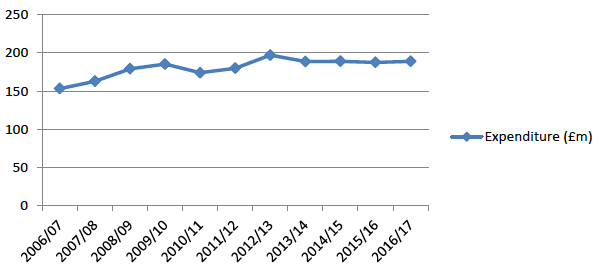
2.18 The fact that people are living longer and leading healthier, more active lives is to be celebrated. However, the fact that there will be more older people year on year does mean that costs for the Scheme are likely to increase further.
2.19 This is why we are looking at options on how best to make sure that the Scheme remains affordable in the coming years.
Options covered
2.20 The Scottish Government is committed to providing access to free bus travel for older and disabled people. The options for change which are consistent with this commitment involve raising the age of eligibility for older people. In this paper, we invite views on whether such changes should be considered at this time, either by raising the age in one go or gradually to bring it into line with the State Pension age, which will be equalised for men and women in 2018.
2.21 In our early engagement with stakeholders a number of other options were raised. These were either inconsistent with our commitment to provide free bus travel or raised practical implementation issues and the Scottish Government is not therefore minded to pursue these. We are, however, open to alternatives and this paper, therefore, invites respondents to offer views on additional or alternative options to improve the scheme and its sustainability. The alternatives raised in early engagement are listed at Annex C along with the reasons why we are not in favour of these.
Proposals at a glance
What are the options for change?
The Scheme currently costs around £192m a year, and around 70,000 Scots turn age 60 each year.
If changes are to be made to the Scheme, the preferred options, in line with our commitment to continue to provide free bus travel for those that need it the most, involve raising the age of eligibility towards the State Pension age. We can therefore:-
- make no change to the scheme, leaving the eligibility rules as they are; or
- raise the age of eligibility for both men and women in one step from 60 to the (female) State Pension age at the time the change is made, thereafter keeping pace with further changes in the State Pension age, which is set to increase to 67 over the period 2026 to 2028; or
- raise the age of eligibility for men and women progressively towards the State Pension age by annual increases of one year or half a year to the age of eligibility, taking longer to get there but lessening the impact on the expectations of individuals close to 60.
Please see Questions 2 and 3 in Annex B for further details.
The rising state pension age
2.22 We recognise that the timing and pace of any change to the age of eligibility is as important as the change itself. This point has been raised by the campaign group Women Against State Pension Inequality (WASPI) and others, who have pointed out the inequality for women in the way changes to the female State Pension age are being made. The 1995 State Pension Act included plans to increase the state pension age for women from 60 to 65, to make it the same as for men.
2.23 WASPI agrees with the principle of equalisation but not with the unfair way the changes were implemented. Because of the way the increases were brought in, hundreds of thousands of women born in the 1950s, who would be affected by the changes, were not informed of them at the time and have only recently become aware that they would have to work for up to five years longer than they had planned. A large percentage of these women received a letter advising them of significant increases to their State Pension age only a year or two before they had expected to receive their State Pension at the age of 60.
2.24 The Scottish Government supports WASPI in pressing their case with the UK Government. This means that if we were to make changes to the age of eligibility to free bus travel for older people, we would consider carefully how to do this in a fair and equitable way. In the options below, we have suggested how a change might be phased in to deal with the issue around the period of notice given to any change in age. In this instance, this is relevant to both men and women since the qualifying age for free bus travel is already aligned.
2.25 The diagram below shows the difference to people of various ages in 2017 between the present situation (getting your bus pass at age 60) and moving either directly to the State Pension age, or moving progressively towards the State Pension age by phasing the arrangements by increments of either +6 months, or +12 months for people in their 50’s in 2017.
Figure 5: Effect of proposed changes on 50+ year olds in 2017
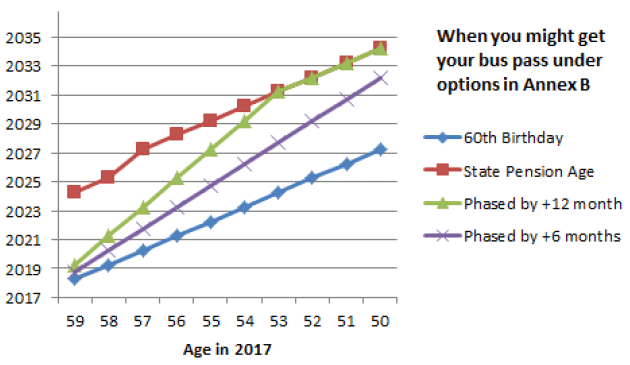
Pre-consultation engagement
2.26 The options set out in Annex B have been arrived at following discussions in the past few months with a number of stakeholder groups. In these discussions a number of ideas were raised as to how we could ensure that the Scheme remains sustainable in the longer term. Some are inconsistent with our commitment to free bus travel and others appear likely to be difficult to implement or operate.
2.27 However, we do not want to close down discussion and we invite alternative or additional suggestions, including whether to make any changes at all to the current eligibility for the Scheme.
2.28 We thank the various organisations and individuals for their participation and help in formulating this Consultation.
2.29 We welcome your views on the Scheme. Annex B contains questions asking if the Scheme age eligibility should stay as it is (Question 1), or if we should change age eligibility towards the State Pension age either at once or progressively (Questions 2 and 3) and on whether you have alternative suggestions (Question 6).